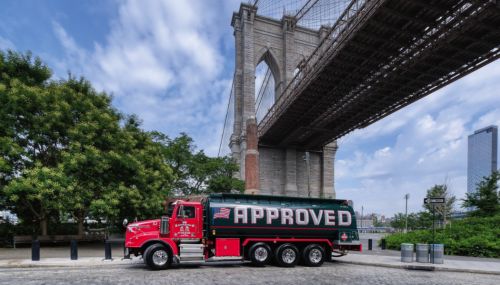All
Ductless Mini Splits Are Taking Off
by Bruce Marshall, Emerson Swan

Contractors can tap into a market that is growing in the Northeast
About a year ago I wrote an article about diversification for the oil heat dealer. Business owners continue to tell me of the different ways in which they have continued to grow their businesses. Without a doubt, the common denominator is air conditioning – one of the fastest growing market segments within the HVAC industry in the United States. And now with the increased popularity of the ductless mini- split, the opportunities for growth have increased significantly.
In the last seven years the U.S. mini-split market has seen a whopping 221 percent growth rate. And it is expected to continue to grow at a rate of 20 percent or more per year. There are many reasons for this phenomenal growth. Among them is the fact that since the introduction of the inverter-based compressor, mini-splits are more energy efficient and quieter than traditional air conditioning systems. And they are much easier to install.
They solve comfort issues where ducted solutions do not work, and there is increased awareness of the ductless option by both homeowners and contractors. For the contractor it is an incremental business with a small investment to support it.
Northeast Is Key Market
Here in the Northeast, we are ideally positioned to take advantage of this growing market. Most people think that the hottest (pun intended) market for ductless might be anywhere other than the often frigid New England states. However, contrary to what you might expect, the Northeast accounts for over 40 percent of the market, while the South owns about 22 percent of ductless sales.
Why? Think retrofit! Our housing stock is mostly old, which can be a challenge when it comes to running ductwork. The joy of ductless is that there is no ductwork, just a line set, and the largest hole that you will have to cut will be a 3-inch opening to the outside for the line set.
Ductless mini-split heat pump systems make a good retrofit add-on to houses with hydronic heat, radiant heat, or stoves using wood or pellets. They are also a good fit for room additions where extending existing ductwork is not feasible.
Apart from the convenience factor, there can be energy savings too, as traditional ducted systems usually have energy losses due to leaks in the system. In older systems, these losses can account for more than 30 percent of energy consumption, especially if the ducts are located in an unconditioned space such as an attic. Mini-splits have no ducts, therefore they do not have the losses associated with ducted central forced air systems.
Good Flexibility
Mini-split systems can be safer too, since there is only a small hole in the wall as opposed to window units or through the wall units, which can provide easy access for burglars. They are easier to install than traditional systems because the only penetration of the house is a 3 inch hole for the line sets to connect the outside unit to the inside unit. Mini-splits offer more interior design flexibility compared to other types of add-on systems. For instance, they can be hung on a wall, suspended from a ceiling, flush mounted into a drop ceiling or floor mounted.
Most indoor units look about the same and are approximately seven inches deep and have sleek, high-tech looking jackets. Many offer the option of remote control to turn the system off or on when it is positioned high on a wall.
There are numerous options in terms of equipment: single unit cool only; single unit heat pump; with or without inverter compressor; multi-head units. There are several manufacturers producing reliable and affordable systems, all of which are manufactured in Asia. In fact, it was the Japanese who developed the ductless market, which is already a huge market outside the United States. The last few years have seen the Chinese manufacturers offer a well made and competitively priced alternative to the established brands.
They Can Heat, Too
For the most part, ductless sales in the Northeast will be driven by cooling needs, but the capability to supplement existing heating systems should not be overlooked. While the passing years have seen a move away from electric heat, the fact that ductless systems are heavily supported by the utilities is evidence of their overall efficiencies. These efficiencies are the result of the inverter technology that allows the compressor to modulate its output based on load. While the traditional “window shaker” boasts a SEER of around 10, mini-splits start at 13 and go into the high 20s.
SEER stands for Seasonal Energy Efficiency Ratio, which equals the output in a typical season (btus/h) divided by the amount of electricity used during that same period (kW). Another acronym to be aware of is EER – Energy Efficiency Ratio. This represents the output versus the electrical input at any given time. And finally there is HSPF or Heating Seasonal Performance Factor, which is specific to air source heat pumps. Like SEER, it is a measurement of total btu output for the season versus the total electrical input.
Utility rebates are based on all three ratings – for cooling, read SEER and EER; for heating, read all three. It is important to remember that a particular mini-split must equal or exceed the stated utility requirements of all ratings to qualify!
Sizing
When it comes to sizing, a handy rule of thumb is to provide 20 btus of cooling for each square foot. This should be sufficient for a typical New England home, but always remember that rule of thumb is no substitute for true heat gain calculations.
Passive or net zero house designers are embracing mini-splits as their sole source for heating and cooling. This is a very feasible option when you take into account the significantly reduced loads of these buildings. Obviously, sizing for such a home would be radically different than for a typical, decades-old house.
Mini-splits offer an excellent alternative to window shakers; they are quieter and more efficient. Non inverter-based systems are less expensive than those with inverters and can be an affordable option for those on a budget.
For the contractor who is thinking of entering the ductless mini-split business, training will be an absolute necessity. Most manufacturers provide some sort of training, and manufacturers representatives such as ours at Emerson Swan, will provide comprehensive training to help the contractor develop the level of comfort necessary to create a profitable business as a part of what you already do or as a completely new, standalone enterprise.
Whatever the case, ductless mini-splits are here to stay and somebody has to install them. Why shouldn’t it be you?
Related Posts
 From Blue Flame to Biofuels
From Blue Flame to Biofuels
Posted on June 25, 2025
 HEAT Show Announces Fenway Park Backyard BBQ
HEAT Show Announces Fenway Park Backyard BBQ
Posted on May 15, 2025
 Delivering New York City’s Clean Energy Solutions
Delivering New York City’s Clean Energy Solutions
Posted on May 14, 2025
 Are You a Leader or a Boss? The Choice is Yours
Are You a Leader or a Boss? The Choice is Yours
Posted on May 14, 2025
Enter your email to receive important news and article updates.
